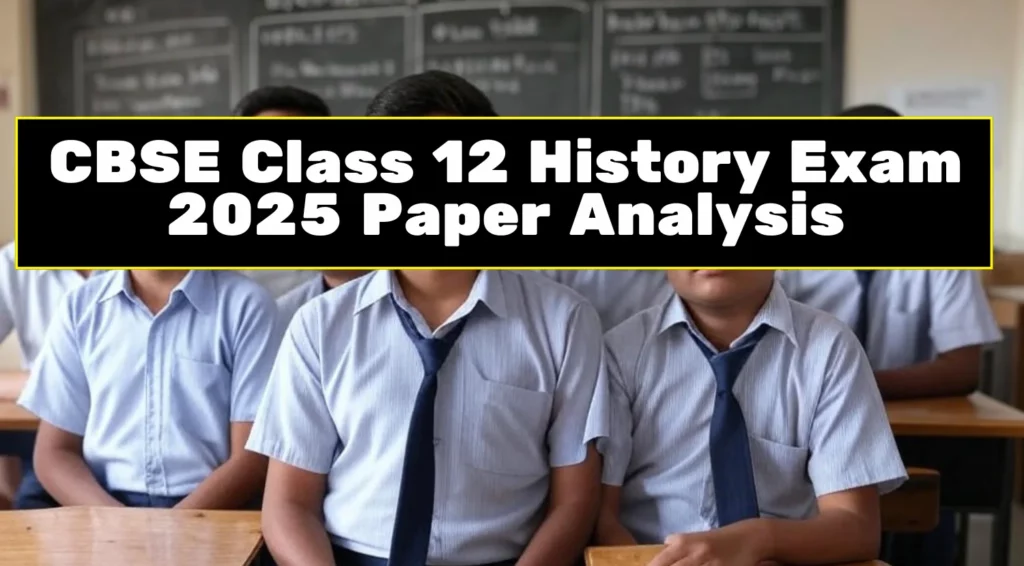CBSE Class 12 History Paper : The CBSE Class 12 History paper presents a structured examination format designed to evaluate students’ understanding of historical concepts and events. The paper typically consists of a total of 30 questions, which are classified into three sections: A, B, and C. Section A usually comprises multiple-choice questions, Section B consists of short answer questions, and Section C includes long answer questions, pushing students to delve deeper into historical analysis. The distribution of marks reflects this segmentation, with each section carrying a specific weight, summing up to a total of 100 marks.
Key themes included in the syllabus, such as ancient, medieval, and modern history, feature prominently within the paper, requiring pupils to demonstrate their knowledge about various civilizations, significant events, and notable historical figures. Students are also tested on their ability to analyze and interpret primary and secondary historical sources, which is reflective of the skills they need to cultivate in preparation for higher education.
This year, compared to previous examinations, the CBSE Class 12 History paper has seen minor adjustments in format and question difficulty. Students have reported that the overall level of the paper was manageable, although some sections posed time-consuming challenges. This variability encourages a more rounded preparation strategy, as knowledge of the core curriculum remains essential. Moreover, it indicates that students should allocate their time wisely across different sections during the exam to accommodate the various question types effectively. As a result, thorough understanding and strategic time management become paramount for success in this evaluation. Understanding these elements will assist students in navigating the examination with confidence and ease.
Analysis of Question Types and Difficulty Levels
The CBSE Class 12 History paper presents a diverse range of question types, each designed to engage students at various levels of understanding and analytical skills. Typically, these questions can be categorized into three main types: objective questions, short answer questions, and long answer questions. Each category has its unique attributes, impacting the overall difficulty level of the paper.
Objective questions typically assess fundamental knowledge, offering students a straightforward approach to demonstrate their understanding of key historical facts, terms, and concepts. These questions are viewed as predominantly easy since they require direct recall of information. Students often find this section manageable, especially if they have a solid grasp of the syllabus content.
On the other hand, short answer questions demand a more nuanced understanding. These questions require students to elaborate on specific topics and provide brief explanations or interpretations. While students may encounter some familiar themes, the need for clarity and conciseness can pose challenges, making this section slightly more complex. Critical thinking is essential in this part, as students are often asked to connect different historical events or evaluate their significance.
Lastly, long answer questions represent the most challenging segment of the paper. These questions necessitate comprehensive analysis and critical evaluation of historical events or perspectives. Candidates must organize their thoughts coherently and provide well-structured arguments, which can be time-consuming and intellectually demanding. It is in this section where students often struggle, as they must not only recall information but also synthesize their understanding in a manner that demonstrates higher-order thinking skills.
In summary, understanding the different question types and their respective difficulty levels can significantly aid students in their preparation for future examinations. By focusing on areas where analysis and critical thinking are required, students can enhance their overall performance in upcoming assessments.
Identifying Time-Consuming Sections
In recent CBSE Class 12 History papers, certain sections have emerged as notably time-consuming for students, often leading to challenges in effectively managing the allocated examination time. A common experience shared among students indicates that questions requiring comprehensive answers, particularly those related to the thematic chapters, necessitate additional time to formulate structured and coherent responses. For instance, topics such as the socio-economic impact of British colonial rule or the complexities of post-independence territorial arrangements often require students to integrate facts, analyze relationships, and provide critical commentary—tasks that can extend the duration needed to answer satisfactorily.
Moreover, students often report that questions demanding critical analysis, where they must draw connections between different historical periods or events, also tend to consume valuable time. An example is the question that involves comparing and contrasting the freedom movements across various regions in India. Such comparative questions not only require the recollection of facts but also entail a deeper understanding of historical narratives and their interconnections.
Given these insights, effective time management emerges as a crucial skill for students facing the CBSE Class 12 History exams. It is advisable for students to allocate their time based on the requirement of each question type. For instance, it may be helpful to prioritize straightforward questions that require direct responses before delving into more intricate analyses. Practicing previous years’ papers or timed mock tests can also establish a rhythm, aiding students in gauging how long they should ideally spend on each section. Equipping oneself with strategies to tackle lengthy questions through outlines or bullet points can further streamline the writing process, ensuring that students maintain a steady pace throughout the examination.
Tips for Future Preparation Based on Paper Analysis
Preparing for the CBSE Class 12 History exam requires a strategic approach, especially in light of the insights gained from the recent paper analysis. The examination highlighted a mix of straightforward questions alongside those that demand intensive analytical skills, making it imperative for students to adapt their study techniques accordingly. One effective strategy is to break down the syllabus into manageable sections. Students should allocate specific time slots for each topic, ensuring a comprehensive understanding. This segmented study method not only alleviates last-minute cramming but also enhances retention.
Utilizing quality resources can significantly aid exam preparation. Textbooks endorsed by the CBSE should be the primary reference, supplemented with reference books known for their clarity and explanatory power. Online platforms offering video lectures, quizzes, and interactive discussions on foundational concepts can further solidify understanding, especially for complex themes such as socio-economic transformations or cultural developments. Additionally, engaging with peer study groups can foster collaborative learning and help clarify doubts.
Revision is a critical component of any successful study plan. Students are encouraged to create concise revision notes that encapsulate key points from each chapter. These notes should include timelines, significant events, and thematic connections, allowing for efficient review as the exam approaches. Furthermore, practicing past papers is crucial. Students should simulate exam conditions by timing themselves while attempting these papers, which will build both their confidence and efficiency in answering questions under pressure.
Overall, the fusion of regular practice, effective resource utilization, and a well-structured revision plan will prepare students to tackle both easy and time-consuming parts of the CBSE Class 12 History paper with increased competence. Establishing these habits early on will not only enhance performance but also cultivate a deeper appreciation for the subject.





